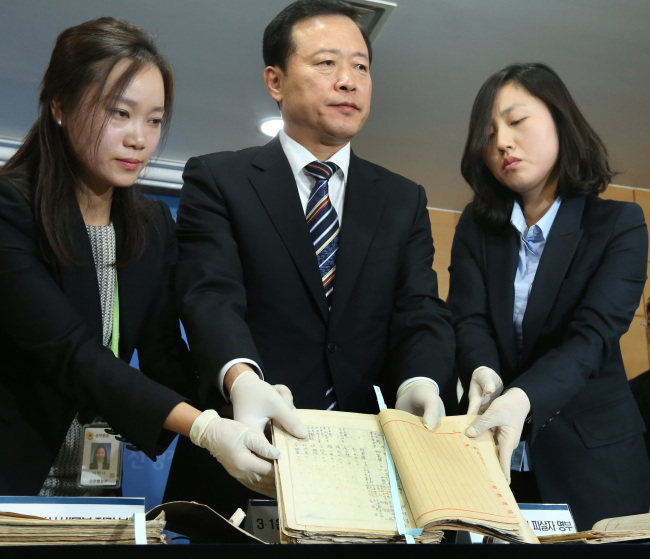한국 정부가 1953년에 전국적으로 조사한 3·1운동과 일본 관동(關東·간토)대지진 피살자 명부가 사상 처음으로 발견, 공개됐다.
이번에 우리나라 최초의 일제 강제징병자 세부 명부도 나와 일제강점기 피해보상 문제가 새로운 전기를 맞을지 주목된다.
국가기록원은 19일 정부서울청사에서 브리핑을 열고 1953년 이승만 정부가 작성한 '3·1운동시 피살자 명부(1권·630명)', '일본 진재(震災)시 피살자 명부(1권·290명)', '일정(日政)시 피징용(징병)자 명부(65권·22만9천781명)' 등 3가지 명부 67권에 대한 분석결과를 공개했다.
이들 명부는 지난 6월 주일대사관 청사 신축에 따른 이사 과정에서 발견된 것이다. 국가기록원은 이를 이관받아 명부별 분석작업을 거쳐 이날 결과를 공개했다.
이들 명부는 1952년 12월 15일 제109회 국무회의에서 이승만 당시 대통령의 지시로 내무부에서 전국적인 조사를 통해 작성한 명부로 1953년 4월 제2차 한일회담을 준비하는 과정에서 작성된 것으로 보인다고 기록원은 밝혔다.
'3·1운동시 피살자명부'에는 1권 217매에 지역별로 모두 630명의 희생자가 실려 있으며 읍·면 단위로 이름, 나이, 주소, 순국일시, 순국장소, 순국상황 등이 자세히 기록돼 있다.
그동안 3·1운동을 하다 순국한 이들 중 공식적으로 인정된 독립유공자 수는 391명에 불과한데, 이번 피살자 명부 발견으로 그 숫자는 3배 가까이로 늘어날 가능성이 있다.
이와 관련, 독립운동가 박은식의 독립운동지혈사에 기록된 3·1운동 피살자 수는 7천509명이다.
'일본 진재(震災)시 피살자 명부'는 1923년 9월 1일 발생한 관동대지진 당시 희생된 한국인 명부로, 1권 109매에 모두 290명의 명단이 기록돼 있다.
관동대지진 당시 한국인 피살자수는 6천661명∼2만명으로 추정되고 있지만 구체적인 희생자 명단이 확인되기는 이번이 처음이다.
이 명부에는 관동대지진 희생자 이름 외에 본적, 나이, 피살일시, 피살장소, 피살상황이 자세히 기록돼 있다.
'일정(日政)시 피징용(징병)자 명부'는 지금까지 작성된 피징용자 명부 중 가장 오래된 원본기록으로, 65권에 22만9천781명의 명단을 담고 있다.
이는 역시 1957년 한국 정부가 작성한 28만5천771명의 왜정시 피징용자명부에 비해 5만5천990명이 적지만 기존 명부에서 확인할 수 없었던 생년월일이나 주소 등이 포함돼 있어 피해보상을 위한 사실 관계 확인에 큰 도움이 될 것이라고 기록원은 내다봤다.
실제로 경북 경산지역의 경우 피징용자 4천285명 중 1천여명이 종전 명부에는 없는 새로운 명단으로 밝혀졌다고 기록원은 설명했다.
박걸순 충북대 사학과 교수는 "3·1운동과 관동대지진 당시 피살자 명부는 지금까지 학계에 알려지지 않은 최초의 기록이라는 점에서 과거사 증빙자료로 역사적 가치가 매우 높다"고 평가했다.
그는 "이들 명부가 정부수립 직후 우리 정부 차원에서 처음으로 전국적인 조사를 통해 작성됐다는 것도 의미가 크다"고 덧붙였다.
기록원은 이번에 수집한 자료를 국가보훈처 등 관련부서에 넘겨 독립유공자 선정과 과거사 증빙자료로 적극 활용될 수 있도록 하는 한편 명부별 세부사항을 정리해 내년 초부터 일반인도 열람할 수 있도록 할 계획이다.
<관련 영문 기사>
South Korea releases new lists of victims of Japan’s colonization
By Song Sang-ho
The Seoul government on Tuesday disclosed newly found lists of nearly 230,000 Korean victims of massacre and forced labor during Japan’s 1910-45 colonial rule.
The revelation shed new light on Japan’s past brutalities and is expected to spark further disputes between the two countries over Japanese apologies and compensation.
The National Archives of Korea released the lists of those who were killed during the March 1 independence movement in 1919 and in an alleged massacre by the Japanese after a devastating earthquake in Kanto in 1923, and who were mobilized for forced labor.
The rosters, contained in 65 books, were unearthed in June at the Korean Embassy in Japan during its renovations and then handed over to the National Archives.
The lists were compiled from nationwide surveys which were conducted in 1953 under the direction of then-President Syngman Rhee as part of preparation for bilateral talks with Tokyo that year, officials said.
One of the books lists 630 victims killed during the 1919 nationwide protests, while another identifies 290 Koreans allegedly slaughtered after the Great Kanto Earthquake. The remainder carries the names of 229,781 Koreans forced to work under colonial rule.
Experts said the rosters would serve as crucial historical records when debating a Japanese apology and compensation for the victims.
“The lists are the results of nationwide surveys and carry details such as the victims’ addresses and dates of birth. So they can be used as grounds for compensation,” National Archives chief Park Gyeong-guk told media.
The list of 630 anti-Japan demonstrators contains detailed information such as their names, ages, addresses, places of their deaths and circumstances in which they were slain. Seoul has so far recognized 391 people as participants in the March 1 Movement.
The records of those killed after the massive quake in 1923 also offers details on the victims such as their hometowns and dates of their deaths. Historians’ estimates put the number of the victims at between 6,661 and 20,000, but it is the first time that details of the victims have surfaced.
As for the rosters of forced laborers, officials said that they were the oldest records ever found. The Seoul government has so far kept track of the victims based on its 1957 documents, which list 285,771 victims -- nearly 56,000 more than the newly discovered rosters.
The government plans to use the lists in selecting nationally recognized independence fighters and back up its demands to Japan for recognition of its history. It will piece them together for public display early next year.
(
sshluck@heraldcorp.com)




![[Herald Interview] 'Trump will use tariffs as first line of defense for American manufacturing'](http://res.heraldm.com/phpwas/restmb_idxmake.php?idx=644&simg=/content/image/2024/11/26/20241126050017_0.jpg)


![[Health and care] Getting cancer young: Why cancer isn’t just an older person’s battle](http://res.heraldm.com/phpwas/restmb_idxmake.php?idx=644&simg=/content/image/2024/11/26/20241126050043_0.jpg)
